Related Research Articles
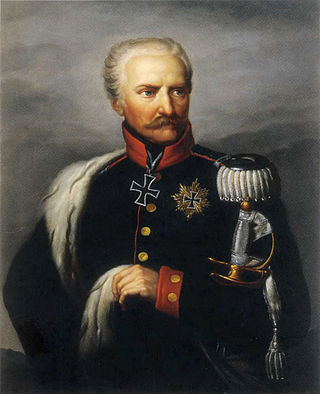
Gebhard Leberecht von Blücher, Graf (count), later elevated to Fürst (prince) von Wahlstatt, was a Prussian Generalfeldmarschall. He earned his greatest recognition after leading his army against Napoleon I at the Battle of the Nations at Leipzig in 1813 and the Battle of Waterloo in 1815.

The Pour le Mérite, also informally known as the Blue Max, is an order of merit established in 1740 by King Frederick II of Prussia. The Pour le Mérite was awarded as both a military and civil honour and ranked, along with the Order of the Black Eagle, the Order of the Red Eagle and the House Order of Hohenzollern, among the highest orders of merit in the Kingdom of Prussia. The order of merit was the highest royal Prussian order of bravery for officers of all ranks.

August Wilhelm Antonius Graf Neidhardt von Gneisenau was a Prussian field marshal. He was a prominent figure in the reform of the Prussian military and the War of Liberation.
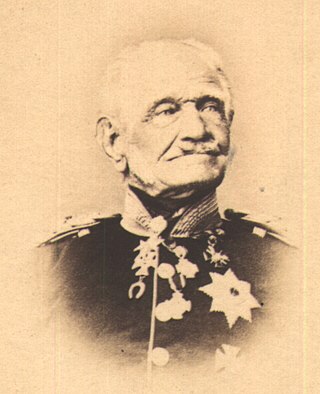
Friedrich Heinrich Ernst Graf von Wrangel was a Generalfeldmarschall of the Prussian Army.
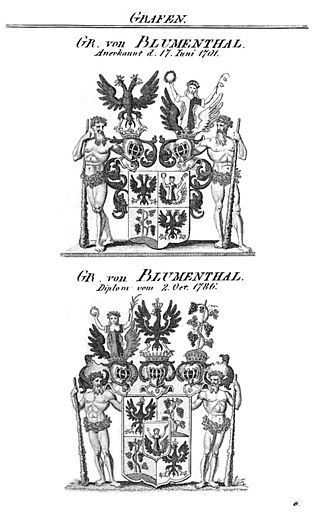
The Blumenthal family is a Lutheran and Roman Catholic German noble family, originally from Brandenburg-Prussia. Other (unrelated) families of this name exist in Switzerland and formerly in Russia, and many unrelated families called Blumenthal, without "von", are to be found worldwide.

Friedrich Emil Ferdinand Heinrich von Kleist, granted the title Graf Kleist von Nollendorf from 1814 onwards, was a Prussian field marshal and a member of the old junker family von Kleist. He was a prominent figure in Prussian military during the Napoleonic Wars.

Hans Ernst Karl, Graf von Zieten was a Prussian Field Marshal who was prominent during the Napoleonic Wars, particularly in the Hundred Days where he took part in several battles in the Waterloo Campaign such as the Battle of Ligny and the Battle of Issy.
Karl Graf von der Gröben was a Prussian general.

Georg Dubislav Ludwig von Pirch was a Prussian lieutenant general who fought in the Napoleonic Wars, participating in the battles of Leipzig and Waterloo. He is sometimes referred as Pirch I to distinguish him from his younger brother, Otto Karl Lorenz von Pirch, referred as Pirch II.
Major General Ferdinand Ernst Wilhelm August von Schmiedeberg (1778–1824) was a Prussian officer during the Napoleonic Wars.
Friedrich Heinrich Ferdinand Leopold von Forcade de Biaix, aka Heinrich Friedrich Ferdinand Leopold von Forcade de Biaix, aka Friedrich Heinrich Ferdinand Leopold Marquis de Forcade de Biaix, was a Royal Prussian lieutenant colonel. He served in the Prussian Army from 1761 to 1793. His last command was as commanding officer of the 10th Prussian Fusilier Battalion, with which he served in the Rhine Campaigns of 1791, where he was awarded the Kingdom of Prussia's highest military order of merit for heroism, Knight of the Order of Pour le Mérite (1791). He left the Prussian Army after 32 years of service in 1793 as the result of invalidity. At the time of his death, he was the owner of Schleibitz Manor, near Oels, Silesia.
Friedrich Wilhelm von Forcade de Biaix, aka Frideric Guillaume de Forcade was a Royal Prussian Colonel, Schwadronschef of the 2nd Grenadier Company in the 24th Prussian Infantry Regiment, recipient of the Kingdom of Prussia's highest military order of merit for heroism, Knight of the Order of Pour le Mérite (1774), Commandant of Frankfurt/Oder, and Presbyter of the French congregation of Frankfurt/Oder.
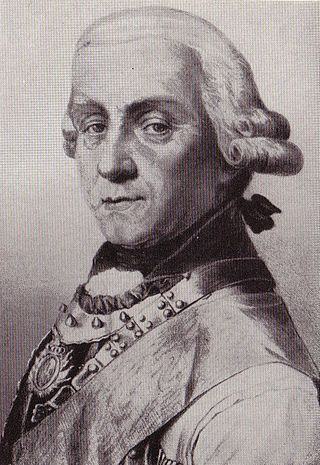
Joachim Bernhardt von Prittwitz and Gaffron (1726–1793) was a Prussian officer credited with saving the life of Frederick the Great at the Battle of Kunersdorf. At the time, he was a cavalry captain in Hans Joachim von Zieten's Hussar regiment. He became the head of gendarmes regiment, and inspector general of the cavalry of Brandenburg March and Magdeburg in 1775. He was promoted to lieutenant general in 1785 and general of cavalry in 1788. Frederick awarded him the Order Pour le Mérite and the Order of the Black Eagle. In 1851, Prittwitz was included on the panels of the Equestrian statue of Frederick the Great as one of the key figures in the establishment of the Prussia state.

Friedrich Wilhelm Gottfried Arnd von Kleist, was a Kingdom of Prussian military officer, who rose to the rank of major general. In the Seven Years' War, he organized and commanded the Freikorps Kleist. He was also known as Green Kleist for his command of the Green Hussar regiment, and to distinguish him from the 58 other members of the Kleist family who served in the war. He received the Order Pour le Mérite and is one of the 25 generals depicted on the Equestrian Statue of Frederick the Great.

Dubislav Friedrich von Platen was a Prussian officer in Frederick the Great's army. A cavalry general, he was also Governor of Königsberg, a Knight of the Order of Saint John, and a recipient of the Order of the Black Eagle. An active cavalry officer in all of the wars fought by Frederick—the War of Austrian Succession, the Second Silesian War, the Seven Years' War and, finally, the War of Bavarian Succession — he was commemorated on Equestrian statue of Frederick the Great in 1851 erected by Frederick's great-great nephew, Frederick William IV.
Joachim Friedrich Christian von Tresckow was a Prussian Lieutenant General, Proprietor of the Prussian Infantry Regiment Nr. 32. He was a Knight of the Black Eagle Order and a recipient of the Order Pour le Mérite. He served Frederick the Great in the War of Austrian Succession and the Seven Years' War.
William Dietrich von Wakenitz, also Wackenitz or Wacknitz, 2 August 1728 on the family estate at Neu Boltenhagen–9 January 1805 in Kassel). He served in the Prussian army during the War of Austrian Succession and the Seven Years' War as a cavalry officer; subsequently, he served the Landgraviate of Hesse-Kassel as general and finance minister.
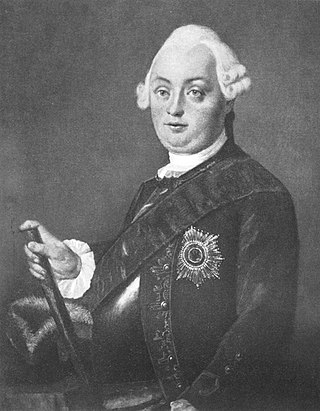
Joachim Friedrich von Stutterheim („Alt-Stutterheim“),. He was known as the Old Stutterheim to distinguish him from his younger brother, Otto Ludwig (1718–1780), also a lieutenant general in Frederick the Great's army.

Ludwig August von Stutterheim served Frederick the Great and his successors in the War of Bavarian Succession, the Kościuszko Uprising, and the wars of the Fourth and Sixth coalitions. In 1794 he earned the prestigious Pour le Mérite award for his distinguished actions. He was promoted major general in 1807 after courageous behavior at the Battle of Eylau. He became a lieutenant general in 1811 and general of the infantry in 1824.

Heinrich Wilhelm von Horn was a Prussian Lieutenant general who fought in the Napoleonic Wars.
References
- ↑ Burnham, Robert, ed. (July 2012), Prussian Generals of the Napoleonic Wars 1793-1815: Sydow, Hans Joachim Friedrich von, Napoleon Series, retrieved 29 January 2014
- ↑ Gustaf Lehmann: Die Ritter des Ordens pour le mérite. Mittler, Berlin 1913, Band 1, S. 320 und Band 2, S. 361.
- ↑ Detlef Wenzlik: Waterloo III Der Feldzug von 1815 - Die Generäle. VRZ Verlag, Hamburg 2008, ISBN 978-3-931482-28-2, S. 52–53.